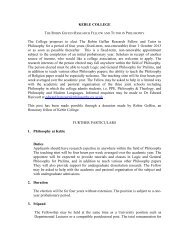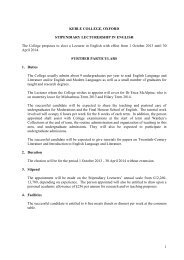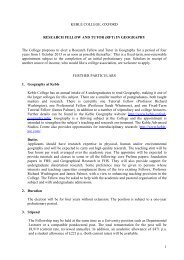The Record 2009 - Keble College - University of Oxford
The Record 2009 - Keble College - University of Oxford
The Record 2009 - Keble College - University of Oxford
You also want an ePaper? Increase the reach of your titles
YUMPU automatically turns print PDFs into web optimized ePapers that Google loves.
<strong>The</strong> <strong>College</strong> at Large<br />
Oceans, overflows and climate<br />
Sonya Legg, BA, (Ph.D.,<br />
London)<br />
When I tell people I’m an oceanographer, they usually imagine<br />
this means I spend my days diving with dolphins. <strong>The</strong> reality<br />
<strong>of</strong> my working life is somewhat more mundane — sitting in front<br />
<strong>of</strong> a computer screen, talking in front <strong>of</strong> a room full <strong>of</strong> scientists<br />
or students, or if I’m very lucky, heading <strong>of</strong>f somewhere as<br />
exotic as Washington DC (a short train ride from New Jersey<br />
where I live) for a funding meeting. Oceanography encompasses<br />
many disciplines and my particular niche within physical<br />
oceanography (the study <strong>of</strong> the circulation, currents, heat and<br />
salt) is turbulent mixing and the role it plays in climate. And my<br />
tool <strong>of</strong> choice is computer simulation, which means I study the<br />
ocean from my <strong>of</strong>fice computer rather than in the ocean itself.<br />
So what does ocean turbulence have to do with climate? Well,<br />
the main role <strong>of</strong> the ocean in the climate system is through heat<br />
storage and transport <strong>of</strong> heat from Equatorial to Polar regions.<br />
Most people have heard something <strong>of</strong> the Gulf Stream, the<br />
great ocean current that carries warm surface water northward<br />
in the North Atlantic Ocean. Without it Western European<br />
winters would be considerably colder. Fewer people, however<br />
(outside my pr<strong>of</strong>ession), have heard <strong>of</strong> its deep counterpart,<br />
the Deep Western Boundary Current, which carries the<br />
return flow <strong>of</strong> cold waters southward. Yet this current plays an<br />
equally important role in our climate as the return loop <strong>of</strong> what<br />
combined is known as the Atlantic Meridional Overturning<br />
Circulation (shown in the schematic). This circulation may<br />
fluctuate on time-scales <strong>of</strong> decades to centuries, leading to<br />
decadal variations in the climate <strong>of</strong> the Atlantic region.<br />
<strong>The</strong> cold deep current is fed by water coming through the<br />
straits which connect the Greenland-Iceland-Norwegian Sea<br />
with the North Atlantic, cold water which results from intense<br />
cooling <strong>of</strong> the surface water by the bitter subpolar winds.<br />
<strong>The</strong>se straits are narrow (when compared to the size <strong>of</strong> the<br />
basin they join) — between 10 and 100km wide — but play a<br />
disproportionately large role in determining the character <strong>of</strong><br />
the deep current. <strong>The</strong> cold water moves through the straits and<br />
accelerates like a rollercoaster down the slope, sinking below<br />
warmer water. <strong>The</strong> regions <strong>of</strong> descending cold water, like<br />
under-sea waterfalls, are known as overflows, and it is here that<br />
turbulence comes into play. More turbulent mixing means a less<br />
dense, less cold current with greater volume, less mixing means<br />
a denser, colder current <strong>of</strong> smaller volume. <strong>The</strong> more mixing,<br />
the more water goes south in the deep current, and the more<br />
warm water has to be pulled north to replace it in the surface<br />
55
















